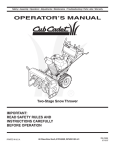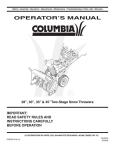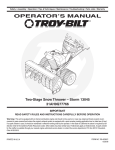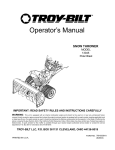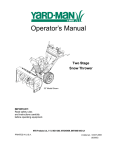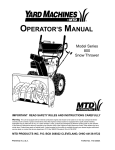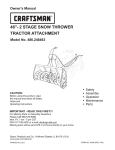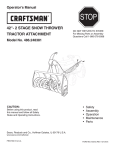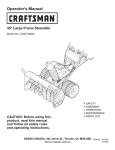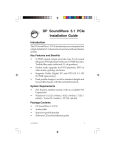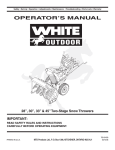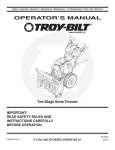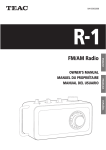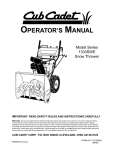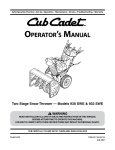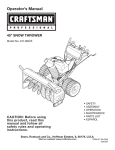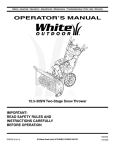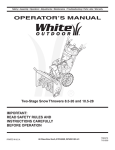Download MTD 769-01534 Cultivator User Manual
Transcript
Safety • Set-Up • Operation • Adjustments • Maintenance • Troubleshooting • Parts Lists • Warranty OPERATOR’S MANUAL Two-Stage Snow Thrower IMPORTANT: READ SAFETY RULES AND INSTRUCTIONS CAREFULLY BEFORE OPERATING EQUIPMENT. PRINTED IN U.S.A. MTD Products Ltd., P. O. Box 1386, KITCHENER, ONTARIO N2G 4J1 769-03342 07/09/07 This Operator’s Manual is an important part of your new snow thrower. It will help you assemble, prepare and maintain the unit for best performance. Please read and understand what it says. Table of Contents Safety Labels....................................................... 3 Safe Operation Practices.................................... 4 Setting Up Your Snow Thrower........................... 6 Operating Your Snow Thrower.......................... 10 MakingAdjustments.......................................... 14 Maintaining Your Snow Thrower....................... 16 Off-Season Storage........................................... 20 Trouble Shooting............................................... 21 Warranty............................................................. 22 Illustrated Parts Lists........................................ 24 Finding and Recording Model Number BEFORE YOU START ASSEMBLING YOUR NEW EQUIPMENT, please locate the model plate on the equipment and copy the model number and the serial number to the sample model plate provided to the right. You can locate the model plate by standing at the operating position and looking down at the frame. -ODEL.UMBER .UM£RODEMODÞLE 3ERIAL.UMBER .UM£RODES£RIE 8888888888 88888888888 WWWMTDCANADACOM -4$02/$5#43,)-)4%$ +)4#(%.%2/..'* Customer Support Please do NOT return the unit to the retailer from which it was purchased, without first contacting Customer Support. If you have difficulty assembling this product or have any questions regarding the controls, operation or maintenance of this unit, you can seek help from the experts. Choose from the options below: 1. Visit www.mtdcanada.ca for many useful suggestions, click on Customer Support button. 2. Call a Customer Support Representative at 1-800-668-1238. 3. The engine manufacturer is responsible for all engine-related issues in terms of performance, power-rating, specifications, warranty, and service. Depending on the engine manufacturer, more information is included in this publication or packed separately with this product. Please have your unit’s model number and serial number ready when you call. See previous section to locate this information. You will be asked to enter the serial number in order to process your call. 1 Safety Labels WARNING #3 Chute Clean-out Tool A chute clean-out tool is fastened to the top of the auger housing with a mounting clip. The tool is designed to clear a chute assembly of ice and snow. This item is fastened with a cable tie at the factory. Cut the cable tie before operating the snow thrower. WARNING: Never use your hands to clear a clogged chute assembly. Shut off engine and remain behind handles until all moving parts have stopped before using the clean-out tool to clear the chute assembly. This symbol points out important safety instructions which, if not followed, could endanger the personal safety and/or property of yourself and others. Read and follow all instructions in this manual before attempting to operate this machine. Failure to comply with these instructions may result in personal injury. When you see this symbol, HEED ITS WARNING! Your Responsibility Restrict the use of this power machine to persons who read, understand and follow the warnings and instructions in this manual and on the machine. 2 Safe Operation Practices WARNING This symbol points out important safety instructions which, if not followed, could endanger the personal safety and/or property of yourself and others. Read and follow all instructions in this manual before attempting to operate this machine. Failure to comply with these instructions may result in personal injury. When you see this symbol, HEED ITS WARNING! Your Responsibility Restrict the use of this power machine to persons who read, understand and follow the warnings and instructions in this manual and on the machine. WARNING: Engine Exhaust, some of its constituents, and certain vehicle components contain or emit chemicals known to State of California to cause cancer and birth defects or other reproductive harm. DANGER: This machine was built to be operated according to the safe operation practices in this manual. As with any type of power equipment, carelessness or error on the part of the operator can result in serious injury. This machine is capable of amputating hands and feet and throwing objects. Failure to observe the following safety instructions could result in serious injury or death. Training Safe Handling of Gasoline 1. Read, understand, and follow all instructions on the machine and in the manual(s) before attempting to assemble and operate. Keep this manual in a safe place for future and regular reference and for ordering replacement parts. 2. Be familiar with all controls and their proper operation. Know how to stop the machine and disengage them quickly. 3. Never allow children under 14 years old to operate this machine. Children 14 years old and over should read and understand the instructions and safe operation practices in this manual and on the machine and be trained and supervised by an adult. 4. Never allow adults to operate this machine without proper instruction. 5. Thrown objects can cause serious personal injury. Plan your snow-throwing pattern to avoid discharge of material toward roads, bystanders and the like. 6. Keep bystanders, helpers, pets and children at least 75 feet from the machine while it is in operation. Stop machine if anyone enters the area. 7. Exercise caution to avoid slipping or falling, especially when operating in reverse. To avoid personal injury or property damage use extreme care in handling gasoline. Gasoline is extremely flammable and the vapors are explosive. Serious personal injury can occur when gasoline is spilled on yourself or your clothes, which can ignite. Wash your skin and change clothes immediately. Preparation 1. Thoroughly inspect the area where the equipment is to be used. Remove all doormats, newspapers, sleds, boards, wires and other foreign objects, which could be tripped over or thrown by the auger/impeller. 2. Always wear safety glasses or eye shields during operation and while performing an adjustment or repair to protect your eyes. Thrown objects which ricochet can cause serious injury to the eyes. 3. Do not operate without wearing adequate winter outer garments. Do not wear jewelry, long scarves or other loose clothing, which could become entangled in moving parts. Wear footwear which will improve footing on slippery surfaces. 4. Use a grounded three-wire extension cord and receptacle for all units with electric start engines. 5. Adjust collector housing height to clear gravel or crushed rock surfaces. 6. Disengage all control levers before starting the engine. 7. Never attempt to make any adjustments while engine is running, except where specifically recommended in the operator’s manual. 8. Let engine and machine adjust to outdoor temperature before starting to clear snow. a. Use only an approved gasoline container. b. Extinguish all cigarettes, cigars, pipes and other sources of ignition. c. Never fuel machine indoors. d. Never remove gas cap or add fuel while the engine is hot or running. e. Allow engine to cool at least two minutes before refueling. f. Never over fill fuel tank. Fill tank to no more than ½ inch below bottom of filler neck to provide space for fuel expansion. g. Replace gasoline cap and tighten securely. h. If gasoline is spilled, wipe it off the engine and equipment. Move machine to another area. Wait 5 minutes before starting the engine. i. Never store the machine or fuel container inside where there is an open flame, spark or pilot light (e.g. furnace, water heater, space heater, clothes dryer etc.). j. Allow machine to cool at least 5 minutes before storing. Operation Maintenance & Storage 1. Do not put hands or feet near rotating parts, in the auger/impeller housing or chute assembly. Contact with the rotating parts can amputate hands and feet. 2. The auger/impeller control lever is a safety device. Never bypass its operation. Doing so makes the machine unsafe and may cause personal injury. 3. The control levers must operate easily in both directions and automatically return to the disengaged position when released. 4. Never operate with a missing or damaged chute assembly. Keep all safety devices in place and working. 5. Never run an engine indoors or in a poorly ventilated area. Engine exhaust contains carbon monoxide, an odorless and deadly gas. 6. Do not operate machine while under the influence of alcohol or drugs. 7. Muffler and engine become hot and can cause a burn. Do not touch. 8. Exercise extreme caution when operating on or crossing gravel surfaces. Stay alert for hidden hazards or traffic. 9. Exercise caution when changing direction and while operating on slopes. 10.Plan your snow-throwing pattern to avoid discharge towards windows, walls, cars etc. Thus, avoiding possible property damage or personal injury caused by a ricochet. 11.Never direct discharge at children, bystanders and pets or allow anyone in front of the machine. 12.Do not overload machine capacity by attempting to clear snow at too fast of a rate. 13.Never operate this machine without good visibility or light. Always be sure of your footing and keep a firm hold on the handles. Walk, never run. 14.Disengage power to the auger/impeller when transporting or not in use. 15.Never operate machine at high transport speeds on slippery surfaces. Look down and behind and use care when backing up. 16.If the machine should start to vibrate abnormally, stop the engine, disconnect the spark plug wire and ground it against the engine. Inspect thoroughly for damage. Repair any damage before starting and operating. 17.Disengage all control levers and stop engine before you leave the operating position (behind the handles). Wait until the auger/impeller comes to a complete stop before unclogging the chute assembly, making any adjustments, or inspections. 18.Never put your hand in the discharge or collector openings. Always use the clean-out tool provided to unclog the discharge opening. Do not unclog chute assembly while engine is running. Shut off engine and remain behind handles until all moving parts have stopped before unclogging. 19.Use only attachments and accessories approved by the manufacturer (e.g. wheel weights, tire chains, cabs etc.). 20.If situations occur which are not covered in this manual, use care and good judgment. Call customer assistance for the name of your nearest servicing dealer. 1. Never tamper with safety devices. Check their proper operation regularly. Refer to the maintenance and adjustment sections of this manual. 2. Before cleaning, repairing, or inspecting machine disengage all control levers and stop the engine. Wait until the auger/impeller come to a complete stop. Disconnect the spark plug wire and ground against the engine to prevent unintended starting. 3. Check bolts and screws for proper tightness at frequent intervals to keep the machine in safe working condition. Also, visually inspect machine for any damage. 4. Do not change the engine governor setting or over-speed the engine. The governor controls the maximum safe operating speed of the engine. 5. Snow thrower shave plates and skid shoes are subject to wear and damage. For your safety protection, frequently check all components and replace with original equipment manufacturer’s (OEM) parts only. “Use of parts which do not meet the original equipment specifications may lead to improper performance and compromise safety!” 6. Check controls periodically to verify they engage and disengage properly and adjust, if necessary. Refer to the adjustment section in this operator’s manual for instructions. 7. Maintain or replace safety and instruction labels, as necessary. 8. Observe proper disposal laws and regulations for gas, oil, etc. to protect the environment. 9. Prior to storing, run machine a few minutes to clear snow from machine and prevent freeze up of auger/impeller. 10.Never store the machine or fuel container inside where there is an open flame, spark or pilot light such as a water heater, furnace, clothes dryer etc. 11.Always refer to the operator’s manual for proper instructions on off-season storage. Do not modify engine To avoid serious injury or death, do not modify engine in any way. Tampering with the governor setting can lead to a runaway engine and cause it to operate at unsafe speeds. Never tamper with factory setting of engine governor. Notice regarding Emissions Engines which are certified to comply with California and federal EPA emission regulations for SORE (Small Off Road Equipment) are certified to operate on regular unleaded gasoline, and may include the following emission control systems: Engine Modification (EM) and Three Way Catalyst (TWC) if so equipped. Average Useful Life According to the Consumer Products Safety Commission (CPSC) and the U.S. Environmental Protection Agency (EPA), this product has an Average Useful Life of seven (7) years, or 60 hours of operation. At the end of the Average Useful Life, buy a new machine or have the machine inspected annually by an authorized service dealer to ensure that all mechanical and safety systems are working properly and not worn excessively. Failure to do so can result in accidents, injuries or death. 2 Safe Operation Practices WARNING This symbol points out important safety instructions, which if not followed, could endanger the personal safety and/or property of yourself and others. Read and follow all instructions in this manual before attempting to operate this machine. Failure to comply with these instructions may result in personal injury. When you see this symbol, HEED IT’S WARNING! Your Responsibility Restrict the use of this power machine to persons who read, understand and follow the warnings and instructions in this manual and on the machine. 3 IMPORTANT: The snow thrower is shipped with oil and WITHOUT GASOLINE. After assembly, refer to separate engine manual for proper fuel and engine oil recommendations. Loose Parts Setting Up Your Snow Thrower • The augers are secured to the auger shaft with shear pins and bow tie cotter pins. If you hit a foreign object or ice jam, the snow thrower is designed so that the pins may shear. Replacement shear pins and cotter pins are provided for your convenience. Store these safely until needed. Items Required For Assembly Pair of pliers Fresh gasoline 7/16” Wrenches or adjustables Before Assembly Figure 1 • Disconnect the spark plug wire and ground it against the engine to prevent unintended starting. • Reference to the right hand or left hand side of machine are observed from the operating position. NOTE: This Operator’s Manual covers several models. Snowthrower featrues vary by model. Not all features referenced in this manual are applicable to all snowthrower models. NOTE: References to right or left side of the snow thrower are determined from behind the unit in the operating position. Assembling Handle • Look at the lower rear of the snow thrower frame to be sure the spring (found at the end of each cable) is attached to its actuator bracket. • Remove the lower handle knobs, washers and carriage bolts from each side of the lower handle. See Figure 2. • Raise the upper handle assembly until it locks over the lower handle. See Figure 1. • Secure the upper handle and lower handle with the handle knobs and carriage bolts previously removed. • Tighten the handle knobs already in place on the upper holes and secure the handles firmly. Figure 2 Attaching Chute Crank • Remove the hairpin clip from the upper chute crank and slide the upper chute crank into the lower chute crank. A pair of pliers may help in this job. See Figure 3. NOTE: Replacement auger shear pins and cotter pins are provided for your convenience. Store these safely until needed. a. Align the two holes on both chute cranks. See Figure 3. b. Secure with the hairpin clip removed earlier. a b Figure 3 3 Setting Up Your Snow Thrower Figure 4 Figure 5 Attaching the Chute Assembly WARNING • Remove locknuts and screws securing one of the flange keepers to the chute assembly. See Figure 4. Prior to operating your snow thrower, refer to Auger Control on page 9. Read and follow all instructions carefully and perform all adjustments to verify your unit is operating safely and properly. • Loosen but do not remove the locknuts and screws on the other two flange keepers. • Slide chute assembly over chute opening, making sure the flange keepers are beneath lip of chute adapter. The notches should engage with the spiral end of the chute crank. See Figure 5. • Secure flange keeper, locknuts and screws previously removed. Tighten all flange keepers and hardware with two 7/16” wrenches. Do not over tighten. NOTE: If necessary the chute crank support bracket can be adjusted so the spiral on the chute crank fully engages the teeth on the chute assembly. Refer to the Adjustment Section. Attaching the Shift Rod • Align the upper and lower shift rods, then slide the shift rod connector down over the end of the lower shift rod. Tap the connector until the lower rod is completely through the connector. See Figure 6. Figure 6 NOTE: If the connector is not properly assembled, the shift rod will pivot and you will not be able to change speeds or direction. NOTE: If the full range of speeds (forward and reverse) cannot be achieved, refer to the Adjustment Section. • Normally the cable ties holding the steering cables against the handle are loosely installed on each side of the lower handle at the factory. Pull the cable ties tight to secure. Cut the excess from the ends of cable ties. • If not already attached, slip the cables that run from the handle panel to the discharge chute into the cable guide located on top of the engine. See Figure 7. • Wrap the wire from the head lamp down the right handle until the wire can be plugged into the alternator lead wire under the fuel tank. See Figure 8. Figure 7 3 Setting Up Your Snow Thrower Drift Cutters (If Equipped) Drift cutters should be used when operating the snow thrower in heavy drift conditions. Alternator Lead • On models so equipped, drift cutters and hardware are assembled to the auger housing inverted. Alternator Lead • Remove the carriage bolts and wingnuts securing the drift cutters to the housing. Lamp Wire • Reposition drift cutters so they face forward as shown in Figure 9. Secure with hardware previously removed, wingnuts should be fastened on the outside of the housing as shown. NOTE: Wheels are omitted from illustration for clarity. Figure 8 If your unit is not equipped with drift cutters, you may contact Customer Support as instructed on page 2 for information regarding price and availability. Snowthrower Model Drift Cutter Kit: All models OEM-390-679 Clean-Out Tool WARNING The clean-out tool is mounted to the rear of the auger housing and is designed to clear a clogged chute. See Figure 10. Refer to the Operation section for more detailed information regarding the chute clean-out tool. Never use your hands to clean snow and ice from the chute assembly or auger housing. NOTE: This item is fastened with a cable tie to the rear of the auger housing at the factory. Cut the cable tie before operating the snow thrower. WARNING: Never use your hands to clean snow and ice from the chute assembly or auger housing. Figure 9 Final Adjustments IMPORTANT Under any circumstance do not exceed manufacturer’s recommended psi. Equal tire pressure should be maintained at all times. Excessive pressure when seating beads may cause tire/rim assembly to burst with force sufficient to cause serious injury. Refer to sidewall of tire for recommended pressure. Make these final adjustments before operating your snow thrower for the first time. Failure to follow these instructions may cause damage to the snow thrower. Clean-Out Tool Wheel Drive Control & Shift Lever Perform the following test to determine need for adjustment: • Move the shift lever into sixth (6) position. See Figure 14. • With the drive control released (see Figure 11A), push the snow thrower forward, then pull it back. The machine should move freely. • Engage the drive control and attempt to move the machine both forward and back, resistance should be felt. Figure 10 • Move the shift lever into the fast reverse (R2) position and repeat the previous two steps. If you experienced resistance rolling the unit, either when repositioning the shift lever from 6 to R2 or when attempting to move the machine with the drive control released, adjust the drive control immediately. To adjust, proceed as follows: 3 B A Setting Up Your Snow Thrower Auger Drive Figure 11 • Loosen the nylock nut on the drive control cable and unthread the cable one full turn. See Figure 13. • Recheck adjustment. • Retighten the nylock nut to secure the cable when correct adjustment is reached. Figure 12 NOTE: For more details, refer to Drive Control Adjustment in the Adjustment Section of this manual. WARNING Auger Control Check the adjustment of the auger control as follows: Never use your hands to clean snow and ice from the chute assembly or auger housing. • When the auger control is released and in the disengaged “up” position (see Figure 11B), the cable should have very little slack, but should NOT be tight. See Figure 12. WARNING:Do not over-tighten the cable. Over-tightening may prevent the auger from disengaging and compromise the safety of the snow thrower. • In a well-ventilated area, start the snow thrower engine as instructed on page 12. Make sure the throttle is set in the fast position. Figure 13 • While standing in the operator’s position (behind the snow thrower) engage the auger. • Thread the nylock nut outward (down the coupler) three full turns to provide more slack in the cable and reattach the spring to the bracket. • Allow the auger to remain engaged for approximately ten seconds before releasing the auger control. Repeat this several times. • Repeat auger control test to verify for proper adjustment. Repeat previous steps to adjust more, if necessary. • With the engine running in the fast position and the auger control lever in the disengaged “up” position, walk to the front of the machine. Skid Shoes • Confirm that the auger has completely stopped rotating and shows no signs of motion. IMPORTANT: If the auger shows any signs of rotating, immediately return to the operator’s position and shut off the engine. Wait for all moving parts to stop before readjusting the auger control cable. • To readjust the control cable, unhook the spring (found on the end of the auger cable) from the auger actuator bracket. See Figure 12. Position the skid shoes based on surface conditions. Adjust upward for hard-packed snow. Adjust downward when operating on gravel or crushed rock surfaces. See “Making Adjustment” Section. Tire Pressure (Pneumatic Tires) The tires are over-inflated for shipping purposes. Check the tire pressure before operating the snow thrower. Refer to the tire side wall for tire manufacturer’s recommended psi and deflate (or inflate) the tires as necessary. • Push the cable coupler through the end of the spring to expose the lock nut. See Figure 13. IMPORTANT If the tire pressure is not equal in both tires, the unit may not travel in a straight path and the shave plate may wear unevenly. 4 Operating Your Snow Thrower Know Your Snow Thrower Drive Control Shift Lever Two-Way Chute Control™ Auger Control Wheel Steering Control Headlight Gas Cap Oil Fill Chute Assembly Chute Directional Control Clean-Out Tool Engine Controls Recoil Starter Handle Electric Starter Outlet Primer WARNING Ignition Key Read, understand, and follow all instructions and warnings on the machine and in this manual before operating. Use extreme care when handling gasoline. Gasoline is extremely flammable and the vapors are explosive. Never fuel the machine indoors or while the engine is hot or running. Extinguish cigarettes, cigars, pipes and other sources of ignition. Drift Cutters (optional) Choke Control Throttle Control Skid Shoe Figure 14 Choke Control Now that you have set up your snow thrower for operation, get acquainted with its controls and features. These are described below and illustrated on this page. This knowledge will allow you to use your new equipment to its fullest potential. NOTE: For detailed starting instructions and more The choke control is found on the rear of the engine and information on all engine controls, refer to the separate is activated by rotating the knob clockwise. Activating the engine manual packed with your unit. choke control closes the choke plate on the carburetor and aids in starting the engine. Shift Lever Throttle Control 6 The shift lever is located in the center of The throttle control is located on the the handle panel and is used to determine 5 engine. It regulates the speed of the ground speed and direction of travel. It can 4 engine and will shut off the engine when be moved into any of eight positions. 3 pushed down completely. IMPORTANT: Always release drive control 2 Primer before changing speeds. 1 F Depressing the primer forces fuel directly Forward: The snow thrower has six into the engine’s carburetor to aid in forward (F) speeds. Position one (1) is the R1 cold-weather starting. R slowest and position six (6) is the fastest. Reverse: The snow thrower has two reverse (R) speeds—R1 is the slower of the two. R2 Oil Fill Engine oil level can be checked and oil added through the oil fill. 34/0 10 Auger Control The auger control is located on the left handle. Squeeze the auger control to engage the augers. Release to stop the snow throwing action. The drive control must also be released in order to stop auger. Drive Control / Auger Control Lock The drive control is located on the right handle. Squeeze the drive control to engage the wheel drive. Release to stop. This same lever also locks the auger control so you can operate the chute crank without interrupting the snow throwing process. If the auger control is engaged simultaneously with the drive control, the operator can release the auger control (on the left handle) and the augers will remain engaged. Release the drive control to stop the augers and wheel drive (the auger control must also be released). IMPORTANT: Always release the drive control before changing speeds. Two-Way Chute Control™) This two-way control lever is meant to control the distance of snow discharge from the chute. Tilt the lever forward or rearward to adjust the distance snow will be thrown. Chute Directional Control The chute directional control is located on left side of the snow thrower. To change the direction in which snow is thrown, turn chute directional control as follows: • Crank clockwise to discharge to the left. CLOCKWISE TO DISCHARGE LEFT COUNTER CLOCKWISE TO DISCHARGE RIGHT Ignition Key The ignition key must be inserted and snapped in place in order for the engine to start. Remove the ignition key to prevent unauthorized use of equipment. Do NOT attempt to turn the key. Chute Clean-Out Tool WARNING: Never use your hands to clear a clogged chute assembly. Shut off engine and remain behind handles until all moving parts have stopped before unclogging. The clean-out tool is conveniently fastened to the rear of the auger housing with a mounting clip. 1. Release both the auger control and the drive/auger control lock. 4 Operating Your Snow Thrower 2. Stop the engine by moving the throttle to the stop position. 3. Remove the clean-out tool from the mounting clip. 4. Use the shovel-shaped end of the clean-out tool to remove any snow and ice in the chute assembly. 5. Re-fasten the clean-out tool to the mounting clip on the rear of the auger housing and restart engine. 6. While standing in the operator’s position (behind the snow thrower), engage the auger control for a few seconds to clear any remaining snow or ice from the chute assembly before continuing to clear snow. Skid Shoes Position the skid shoes based on surface conditions. Adjust upward for hard-packed snow. Adjust downward when operating on gravel or crushed rock surfaces. See “Making Adjustment” Section. Headlight The headlight is on whenever the engine is running. WARNING The operation of any snow thrower can result in foreign objects being thrown into the eyes, which can damage your eyes severely. Always wear safety glasses while operating the snow thrower, or while performing any adjustments or repairs on it. Be sure no one other than the operator is standing near the snow thrower while starting engine or operating snow thrower. Never run engine indoors or in enclosed, poorly ventilated areas. Engine exhaust contains carbon monoxide, an odorless and deadly gas. Keep hands, feet, hair and loose clothing away from any moving parts on engine and snow thrower. • Crank counterclockwise to discharge to the right. Wheel Steering Controls The left and right wheel steering controls are located on the underside of the handles. Squeeze the right control to turn right; squeeze the left control to turn left. NOTE: Operate the snow thrower in open areas until you are familiar with these controls. 11 4 Operating Your Snow Thrower Gas & Oil Fill-Up Service the engine with gasoline and oil as instructed in the separate engine manual packed separately with your snow thrower. Read instructions carefully. Starting The Engine 1. Attach spark plug wire to spark plug. Make certain the metal loop on the end of the spark plug wire (inside the rubber boot) is fastened securely over the metal tip on the spark plug. 2. Make certain both the auger control and drive control are in the disengaged (released) position. 3. Move throttle control up to FAST position. Insert ignition key into slot. Make sure it snaps into place. Do not attempt to turn the key. NOTE: The engine cannot start unless the key is inserted into ignition switch. WARNING Read, understand, and follow all instructions and warnings on the machine and in this manual before operating. Use extreme care when handling gasoline. Gasoline is extremely flammable and the vapors are explosive. Never fuel the machine indoors or while the engine is hot or running. Extinguish cigarettes, cigars, pipes and other sources of ignition. Electric Starter (on certain models) 1. Determine that your home’s wiring is a three-wire grounded system. Ask a licensed electrician if you are not certain. WARNING: The optional electric starter is equipped with a grounded three-wire power cord and plug, and is designed to operate on 120 volt AC household current. It must be used with a properly grounded three-prong receptacle at all times to avoid the possibility of electric shock. Follow all instructions carefully prior to operating the electric starter. If your home’s wiring system is not a three-wire grounded system, do not use this electric starter under any conditions. If your home electrical system is grounded, but a three-hole receptacle is not available, one should be installed by a licensed electrician before using the electric starter. If you have a grounded three-prong receptacle, proceed as follows: 1. Plug the extension cord into the outlet located on the engine’s surface. Plug the other end of extension cord into a three-prong 120-volt, grounded, AC outlet in a well-ventilated area. 2. Rotate choke control to FULL choke position (for a cold engine start). NOTE: If the engine is already warm, place choke control in the OFF position instead of FULL. 3. Push the primer two or three times for cold engine start, making sure to cover vent hole in the center of the primer when pushing. 5. Once the engine starts, immediately release starter button. 6. As the engine warms, slowly rotate the choke control to the OFF position. If the engine falters, quickly rotate the choke control back to FULL and then slowly into the OFF position again. 7. When disconnecting the extension cord, always unplug the end at the three-prong wall outlet before unplugging the opposite end from the snow thrower. Recoil Starter 1. Rotate choke control to FULL choke position (cold engine start). NOTE: If the engine is already warm, place choke control in the OFF position instead of FULL. 2. Push the primer two or three times for cold engine start, making sure to cover vent hole in the center of the primer when pushing. NOTE: DO NOT use primer to restart a warm engine after a short shutdown. NOTE: Additional priming may be necessary if the temperature is below 15° F. (-9° C). 3. Grasp the recoil starter handle and slowly pull the rope out. At the point where it becomes slightly harder to pull the rope, slowly allow the rope to recoil. 4. Pull the starter handle with a firm, rapid stroke. Do not release the handle and allow it to snap back. Keep a firm hold on the starter handle and allow it to slowly recoil. 5. As the engine warms, slowly rotate the choke control to the OFF position. If the engine falters, quickly rotate the choke control back to the FULL position and then slowly into the OFF position again. NOTE: Allow the engine to warm up for a few minutes after starting. The engine will not develop full power until it reaches operating temperatures. Stopping The Engine Run engine for a few minutes before stopping to help dry off any moisture on the engine. • Move throttle control to STOP position. • Remove the ignition key (Do not turn key) to prevent unauthorized use of equipment. NOTE: Keep the key in a safe place. The engine cannot start without the ignition key. • Wipe all snow and moisture from the area around the engine as well as the area in and around the drive control and auger control. Also, engage and release both controls several times. NOTE: DO NOT use primer to restart a warm engine after a short shutdown. 4. Push starter button to start engine. 12 To Engage Drive Operating Tips 1. With the engine running near top speed, move shift lever to one of six FORWARD positions or two REVERSE positions. Select a speed appropriate for the snow conditions that exist. NOTE: Allow the engine to warm up for a few minutes. The engine will not develop full power until it reaches operating temperature. WARNING: The temperature of the muffler and the surrounding areas may exceed 150° F (65° C). Avoid these areas. 2. Squeeze drive control against the right handle and the snow thrower will move. Release it and the drive motion will stop. To Engage Augers 1. If possible, remove snow immediately after it falls. 1. To engage augers and start snow throwing, squeeze the left hand auger control against the left handle. Release to stop augers. 2. Discharge snow downwind whenever possible. 2. While the auger control is engaged, squeeze the drive control to move, release to stop. Do not shift speeds while the drive is engaged. NOTE: This same lever also locks auger control so you can turn the chute control without interrupting the snow throwing process. 3. Release the auger control; the interlock mechanism should keep the auger control engaged until the drive control is released. 4. Release the drive control to stop both the augers and the wheel drive. To stop the auger, both levers must be released. 4 Operating Your Snow Thrower 3. Slightly overlap each previous path. 4. Set the skid shoes 1/4” below the shave plate for normal usage. Adjust them upward for hard-packed snow and downward when using on gravel or crushed rock. General Recommendations 1. Always observe safety rules when performing any maintenance. 2. The warranty on this snow thrower does not cover items that have been subjected to operator abuse or negligence. To receive full value from warranty, operator must maintain the snow thrower as instructed here. 3. Some adjustments will have to be made periodically to maintain your unit properly. WARNING The muffler, engine and surrounding areas become hot and can cause a burn 150°F (65°C). Do not touch. 4. Periodically check all fasteners and make sure these are tight. NOTE: Use slower speeds in higher snow and/or until you are familiar with the snow thrower operaIMPORTANT NEVER move the shift lever without first releasing the wheel drive control. Doing so will cause premature wear on the drive system’s friction wheel. 13 5 Making Adjustments Figure 15 WARNING Read, understand, and follow all instructions and warnings on the machine and in this manual before operating. Never attempt to make any adjustments while the engine is running, except where specified in operator’s manual. Shift Rod If the full range of speeds (forward and reverse) cannot be achieved, refer to Figure 15 and adjust the shift rod as follows: 1. Looking underneath the handle panel, note which of the three holes in the shift lever the ferrule is inserted into. Also note the direction of insertion. Then remove the internal cotter pin and flat washer from the ferrule and withdraw the ferrule from the shift lever. See Figure 15. Figure 16 Friction Wheel 2. Place shift lever in sixth (6) position or fastest forward speed. 3. Push shift rod and shift arm assembly down sharply, as far as it will go to put the drive into the fastest forward position. Drive Plate 4. As necessary, rotate the ferrule up or down the shift rod until the ferrule lines up with the hole from which it was earlier removed. See Figure 15. 5. From the direction noted earlier, insert the ferrule into the proper hole. Axle Supp. Brkt. Opening Figure 17 6. Reinstall the washer and the internal cotter pin. Drive Control Refer to the Final Adjustment section of the Set-Up instructions to adjust the drive control. To further check the adjustment, proceed as follows: 1. Drain the gasoline out of your snow thrower’s engine, and place a piece of plastic film under the gas cap to avoid spillage. 2. Tip the snow thrower forward, allowing it to rest on the auger housing. 5. With the drive control lever engaged, check if the friction wheel solidly contacts the drive plate. See Figure 17. If not, adjust as follows: a. Loosen the jam nut on the traction drive cable and thread the cable in or out as necessary. b. Retighten the jam nut to secure the cable when correct adjustment is reached. 6. Reassemble the frame cover. NOTE: If you placed plastic film under the gas cap earlier, remove it now. 3. Remove the frame cover underneath the snow thrower by removing the self-tapping screws. See Figure 16. 4. With the wheel drive control released, check if there is clearance between friction wheel and drive plate in all positions of the shift lever. See Figure 17. 14 5 Skid Shoes The space between the shave plate and the ground can be adjusted by raising or lowering the skid shoes. For close snow removal, as when using on a smooth concrete or asphalt driveway, place the skid shoes in the low position. Use the middle or high position when the area to be cleared is uneven. When operating on gravel, always put skid shoes in the high position. See Figure 18. Making Adjustments Adjust skid shoes as follows: 1. Loosen, but do not remove, the hex flange locknuts which fasten the skid shoe to the auger housing. 2. Raise or lower the skid shoe to desired position. 3. Retighten the hex nuts loosened earlier. NOTE: Make certain the bottom surface of skid shoe is flat against the ground to avoid uneven wear. Figure 18 IMPORTANT: It is not recommended that you operate this snow thrower on gravel as loose gravel can be easily picked up and thrown by the auger causing personal injury or damage to the snow thrower. 4. Repeat on the other side of the snow thrower. Auger Control Refer to instructions on page 9 to adjust the auger control. Make certain to check for correct adjustment as instructed before operating the snow thrower. Chute Assembly The distance snow is thrown can be adjusted by adjusting the angle of the chute assembly. Refer to page 9 for instructions. The remote chute control cables have been pre-adjusted at the factory. Move the remote chute lever on the control panel back and forward to adjust angle of the chute assembly. Chute Bracket Adjustment Figure 19 If the spiral at the bottom of the chute directional control is not fully engaging with the chute assembly, the chute bracket can be adjusted. To do so: 1. Loosen the two nuts which secure the chute bracket and reposition it slightly. See Figure 19. 2. Retighten the nuts. 15 If for some reason, you have to operate the snow thrower on gravel, keep the skid shoe in the highest position for maximum clearance between the ground and the shave plate. 6 Maintaining Your Snow Thrower Lubrication Gear (Hex) Shaft Friction Wheel IMPORTANT: Keep all grease and oil off the rubber friction wheel and drive plate. Wheels At least once a season, remove both wheels. Clean and coat the axles with a multipurpose automotive grease before reinstalling wheels. Drive Plate Auger Shaft At least once a season, remove the shear pins on auger shaft. Spray lubricant inside shaft, around the spacers. Also lubricate the flange bearings found at either end of the shaft. See Figure 21. Figure 20 WARNING Always stop engine, disconnect spark plug, and ground against engine before cleaning, lubricating or doing any kind of maintenance on your machine. Drive and Shifting Mechanism At least once a season or after every 25 hours of operation, remove rear cover. Lubricate any chains, sprockets, gears, bearings, shafts, and the shifting mechanism at least once a season. Use engine oil or a spray lubricant. Refer to Figure 20. Shear Pin Grease Fitting (optional) Vent Plug Auger Shaft Augers • The augers are secured to the spiral shaft with shear pins and cotter pins. If the auger should strike a foreign object or ice jam, the snow thrower is designed so that the pins may shear. See Figure 21. • If the augers will not turn, check to see if the pins have sheared. One set of replacement shear pins has been provided with the snow thrower. When replacing pins, spray an oil lubricant into shaft before inserting new pins. Cotter Pin Spacers Bearing Figure 21 IMPORTANT Avoid oil spillage on rubber friction wheel and aluminum drive plate. Shave Plate and Skid Shoes The shave plate and skid shoes on the bottom of the snow thrower are subject to wear. They should be checked periodically and replaced when necessary. To remove skid shoes: 1. Remove the carriage bolts (and washers if equipped)and hex flange nuts which secure the skid shoes to the snow thrower. 2. Reassemble new skid shoes with previously removed hardware. Refer to Figure 22. To remove shave plate: 1. Remove the carriage bolts and hex nuts which attach it and the skid shoes to the snow thrower housing. 2. Reassemble new shave plate, making sure heads of carriage bolts are to the inside of housing. Tighten securely. Figure 22 Engine Refer to the separate engine manual packed with your unit for all engine maintenance and lubrication instructions. 16 Replacing Belts To remove and replace either the auger belt or the drive belt, follow the steps below and then proceed to the specific steps listed under respective sub-headings. 1. Disconnect the chute crank assembly at the discharge chute end by removing the hairpin clip and the flat washer. See Figure 19. 2. Remove the plastic belt cover, located near the engine, by removing the three self-tapping screws that secure it. See Figure 23. 3. a.Loosen the bolt shown in Figure 24 securing the belt keeper bracket and remove the other bolt. b.Push the belt keeper and bracket up off the engine pulley. See Figure 25. Auger Belt 4. Remove the hairpin clip and flat washer from the ferrule in order to disconnect the auger idler rod from the brake bracket assembly. See Figure 26. 5. Slip the auger control belt (the front belt) off the engine pulley. 6 Maintaining Your Snow Thrower 6. Pull the brake bracket assembly towards the cable guide roller and unhook the auger cable “Z” fitting. See Figure 27. 7. Remove the hex screws which attach the auger housing assembly to the frame assembly using a 1/2” wrench. Refer to Figure 28. 8. Place a block of wood underneath the auger housing as shown in Figure 29 and separate auger housing from the frame by tilting the housing forward and pulling up the handles. Figure 23 Remove IMPORTANT NEVER replace the auger shear pins with standard pins. Any damage to the auger gearbox or other components, as a result of doing so, will NOT be covered by your snow thrower’s warranty. Check the condition of both auger belt and drive belt every 25 hours of snow thrower operation. Replace if either shows signs of wear and tear. Loosen Figure 24 Figure 26 Figure 27 Figure 25 17 Specifications are subject to change without notification or obligation. Images may not reflect your exact model and are for reference purposes only. 6 Maintaining Your Snow Thrower Figure 29 Figure 28 WARNING Always stop engine, disconnect spark plug, and ground against engine before cleaning, lubricating or doing any kind of maintenance on your machine. b 9. a. Using a 1/2” wrench, remove the hex screw and washer from the center of the pulley on the auger housing. See Figure 30. b. Lift the brake bracket assembly out of the pulley groove c. Remove the pulley. 10.Remove and replace auger belt inside belt keepers. Adapter 11. Apply Loctite 262 to the threads of the hex screw used for mounting the auger pulley. 12.Reassemble pulley to auger housing aligning pulley slots with posts on adapter, secure with hex screw and washer. Torque hex screw 250-325 in. lbs. c Slots a NOTE: Make sure the brake puck is seated in the pulley groove. Figure 30 If also replacing the drive belt, proceed to the “Drive Belt” instruction. If not, reassemble by performing the previous steps in the opposite order and manner of removal. 1 3 Proper Adjustment: With the auger clutch lever in the disengaged position, the top surface of the new belt should be even with the outside diameter of the pulley. 1. To adjust, disconnect ferrule from brake bracket assembly and thread ferrule in (towards idler) to increase tension on belt, and out to decrease tension. IMPORTANT Refer to the Final Adjustment section of the Set-Up instructions after replacing drive and auger belts. NOTE: The brake puck must always be firmly seated in the pulley groove when auger control is disengaged. 2 IMPORTANT: Repeat the “Auger Drive Control Test” from the Assembly section before operating snow thrower. Drive Belt 1. Pull the idler pulley away from the backside of the drive belt to relieve the tension and slide the drive belt off the idler pulley. See Figure 31. 2. Remove the belt from the bottom drive pulley and the engine pulley. Figure 31 3. Install the new belt on the pulleys in the reverse order and re-tension with the idler pulley. Reassemble your unit by performing the previous steps in the opposite order. 18 Changing Friction Wheel Rubber • Drain the gasoline from the snow thrower, or place a piece of plastic under the gas cap. • Tip the snow thrower up and forward, so that it rests on the housing. • Remove screws from the frame cover underneath the snow thrower. See Figure 16. Friction Wheel Assembly Remove hex screw and washer Hex Shaft Slide hex shaft • Remove the right wheel from the axle. 6 Maintaining Your Snow Thrower • Using a 3/4” wrench, hold the hex shaft and remove the hex bolts and cupped washer and bearing from left side of the frame. Refer to Figure 32. • Holding the friction wheel assembly, slide the hex shaft out of the right side of the unit. The spacer on the left side of the hex shaft will fall and the sprocket should remain hanging lose in the chain. Figure 32 WARNING • Lift the friction wheel assembly out between the axle shaft and the drive shaft assemblies. • Remove four screws securing the friction wheel rubber between the friction wheel plates. See Figure 33. Discard old rubber. • Reassemble the new friction wheel rubber to the friction wheel assembly, tightening the four screws in rotation and with equal force. It is important to assemble the rubber on the friction wheel symmetrically for proper functioning. • Insert the pin from the shift arm assembly into the friction wheel assembly and hold assembly in position. Refer to Figure 34. • Slide the hex shaft through the right side of the housing and through the friction wheel assembly. Friction Wheel Figure 33 • Insert the hex shaft through the sprocket and the spacer. Make certain that the chain engages both the large and the small sprocket. NOTE: If the sprocket fell from the snow thrower while removing the hex shaft, place the sprocket on the hex shaft. Position the hex hub of the sprocket toward the friction wheel when sliding the sprocket on to the hex shaft. • Slide the bearing onto the left end of the hex shaft and press into the hole on the left side the frame. • Secure with the cupped washer and hex bolt removed earlier. • Secure the frame cover with self-tapping screws. Put the snow thrower down to its normal operating position. NOTE: If you placed plastic film under the gas cap, be certain to remove it. Figure 34 19 The rubber on the friction wheel is subject to wear and should be checked after the first 25 hours of operation, and periodically thereafter. Replace the friction wheel rubber if any signs of wear or cracking are found. 7 Off-Season Storage Observe the following, when preparing your snow thrower for off-season storage: • Drain fuel into an approved container outdoors, away from any open flame. Allow engine to cool. Extinguish cigarettes, cigars, pipes and other sources of ignition prior to draining fuel. Fuel left in engine during warm weather deteriorates and will cause serious starting problems. • If unit is to be stored over 30 days, prepare for storage as instructed in the separate engine manual packed with your unit. • Run engine until fuel tank is empty and engine stops due to lack of fuel. • Remove gasoline from carburetor and fuel tank to prevent gum deposits from forming on these parts and causing possible malfunction of engine. WARNING Never store snow thrower with fuel in tank indoors or in poorly ventilated areas, where fuel fumes may reach an open flame, spark or pilot light as on a furnace, water heater, clothes dryer or gas appliance. • Drain carburetor by pressing upward on bowl drain, located below the carburetor cover. • Fuel stabilizers, such as STA-BIL®, are an acceptable alternative in minimizing the formation of fuel gum deposits during storage. Do not drain carburetor if using a fuel stabilizer. • Wipe equipment with an oiled rag to prevent rust. • Remove spark plug and pour one ounce of engine oil through spark plug hole into cylinder. Cover spark plug hole with rag. Crank engine several times to distribute oil. Replace spark plug. • Follow the lubrication recommendations found in the Maintenance Section. • Always store the snow thrower in a clean, dry area. Drain fuel into an approved container outdoors, away from any open flame. Be certain engine is cool. Do not smoke. Fuel left in engine during warm weather deteriorates and will cause serious starting problems. Do not drain carburetor if using fuel stabilizer. Never use engine or carburetor cleaning products in the fuel tank or permanent damage may occur. 20 Problem Cause Engine fails to start 1. Choke not in ON position. 1. Move choke to ON position. 2. Spark plug wire disconnected. 2. Connect wire to spark plug. 3. Fuel tank empty or stale fuel. 3. Fill tank with clean, fresh gasoline. 4. Engine not primed. 4. Prime engine as instructed in “Operating Your Snow Thrower”. 5. Faulty spark plug. 5. Clean, adjust gap, or replace. 6. Blocked fuel line. 6. Clean fuel line. 7. Safety key not in ignition on engine. 7. Insert key fully into the switch. 8. Fuel shut-ff valve closed. (If Equipped) 8. Open fuel shut-off valve. 1. Unit running on CHOKE. 1. Move choke lever to OFF position. 2. Blocked fuel line or stale fuel. 2. Clean fuel line; fill tank with clean, fresh gasoline. 3. Water or dirt in fuel system. 3. Drain fuel tank. Refill with fresh fuel. 4. Carburetor out of adjustment. 4. Contact Service Center. Engine overheats 1. Carburetor not adjusted properly. 1. Contact Service Center. Excessive Vibration 1. Loose parts or damaged auger. 1. Stop engine immediately and disconnect spark plug wire. Tighten all bolts and nuts. If vibration continues, have unit serviced by a Service Center. Loss of power 1. Spark plug wire loose. 1. Connect and tighten spark plug wire. 2. Gas cap vent hole plugged. 2. Remove ice and snow from gas cap. Be certain vent hole is clear. 3. Exhaust port plugged. 3. Contact Service Center. 1. Drive control cable in need of adjustment. 1. Adjust drive control cable. Refer to “Adjustments”. 2. Drive belt loose or damaged. 2. Replace drive belt. 1. Chute assembly clogged. 1. Stop engine immediately and disconnect spark plug wire. Clean chute assembly and inside of auger housing with clean-out tool or a stick. 2. Foreign object lodged in auger. 2. Stop engine immediately and disconnect spark plug wire. Remove object from auger with clean-out tool or a stick. 3. Auger control cable in need of adjustment. 3. Refer to “Auger Control Test” . 4. Auger belt loose or damaged. 4. Refer to Maintenance section. 5. Shear pin(s) sheared. 5. Replace with new shear pin(s). Engine runs erratic Unit fails to propel itself Unit fails to discharge snow 21 Remedy 8 TroubleShooting NOTE: This section addresses minor service issues. For further details, contact customer assistance. 9 Warranty Failure to comply with suggested maintenance and lubrication specifications will void warranty. FOUR YEAR SUPREME WARRANTY: For four years from date of retail purchase within Canada, MTD PRODUCTS LIMITED will, at its option, repair or replace, for the original purchaser, free of charge, any part or parts found to be defective in material or workmanship. This warranty covers units which have been operated and maintained in accordance with the owner’s instructions furnished with the unit, and which have not been subject to misuse, abuse, commercial use, neglect, accident improper maintenance or alteration. Normal wear parts or components thereof are subject to special terms as noted below in the Ninety Day Consumer Warranty clause. The engine, starter motor or component parts thereof carry separate warranties from their manufacturers. Please refer to the applicable manufacturer’s warranty policy for these items. Ninety Day Consumer Warranty on Normal Wear Parts: All normal wear part failures will be covered on this product for a period of 90 days. After 90 days but within the four year warranty period, normal wear part failures will be covered if caused by defects in material or workmanship of other component parts. Normal wear parts are defined as batteries, belts, blades, blade adaptors, grass bags, rider deck wheels, seats, tires and clutch parts (friction wheels). Full Ninety Day Warranty on Battery (if equipped): For ninety (90) days from the date of retail purchase, if any battery included with this unit proves defective in material or workmanship and our testing determines the battery will not hold a charge, MTD PRODUCTS LIMITED will replace the battery at no charge to the original purchaser. Additional Limited Thirty Day Warranty on Battery (if equipped): After ninety (90) days but within one hundred twenty (120) days from the date of purchase, MTD PRODUCTS LIMITED will replace the defective battery, for the original purchaser, for a cost of one-half (½) of the current retail price of the battery in effect at the date of return. Personal use: THE FOREGOING PARAGRAPHS CONSTITUTE THE MANUFACTURER’S ENTIRE WARRANTY WITH RESPECT TO ANY PRODUCT PURCHASED AND USED FOR PERSONAL FAMILY, HOUSEHOLD/RESIDENTIAL PURPOSES, AS DISTINGUISHED FROM COMMERCIAL USAGE. Commercial use: ALL APPLICATIONS OTHER THAN PERSONAL USE AS OUTLINED ABOVE, ARE CONSIDERED COMMERCIAL USAGE. New products purchased for commercial usage are warranted in the same manner and to the same extend EXCEPT the term of warranty will be 90 DAYS from date of purchase. How to Obtain Service: Warranty service is available, with proof of purchase, through your local MTD Authorized Service Dealer. If you do not know the dealer in your area, please write to the Service Department of MTD PRODUCTS LIMITED, P.O. BOX 1386, KITCHENER, ONTARIO N2G 4J1. The return of a complete unit will not be accepted by the factory unless prior written permission has been extended by MTD PRODUCTS LIMITED. Other Warranties: All other warranties, express or implied, including any implied warranty of merchantability is limited in its duration to that set forth in this express limited warranty. The provisions as set forth in this warranty provide the sole and exclusive remedy of MTD PRODUCTS LIMITED obligations arising from the sale of its products. MTD PRODUCTS LIMITED will not be liable for incidental or consequential loss or damage. 12.08.06 22 NOTES: For parts and/or accessories refer to customer support on page 2. Adressez-vous au «Service après-vente» à la page 2 pour ce qui concerne les pièces et/ou accessoires. 23 4 7 53 68 71 39 61 64 65 60 47 50 24 2 21 47 37 14 62 41 70 71 31 16 26 20 5 10 6 32 19 2 34 13 57 19 33 18 69 48 31 38 66 A 67 19 8 3 9 54 52 29 57 19 69 40 63 44 43 22 30 49 53 42 1 35 19 25 45 36 68 58 21 28 47 15 52 51 59 27 16 A 56 23 55 46 28 11 28 24 12 REF NO. N° DE RÉF 1 2 3 4 5 6 7 8 9 10 11 12 13 14 15 16 18 19 20 21 22 23 24 25 26 27 28 29 30 31 32 33 34 35 36 37 38 39 40 41 42 43 44 45 46 47 48 49 50 51 52 53 54 55 56 57 58 59 60 61 62 63 64 65 66 67 68 69 70 71 PART NO. N° DE PIÈCE 784-5604A 646-0012 684-0053B 705-5218 705-5219 705-5266 710-0458 710-0572 784-5594 710-1625 710-04682 710-3118 710-3015 711-0677 784-5679 712-04064 714-0101 714-0104 720-0201A 720-04039 720-0284 725-0157 784-5682 784-5681 726-0100 748-0363 736-0105 736-0185 736-0242 736-0275 741-0475 746-0950A 747-0624 747-0983A 747-0997 784-5680 749-0989A 749-0990A 749-0991 750-0963 684-0102A 710-0276 710-0458 710-0459A 710-0597 710-0599 710-0805 710-0895 711-0653 712-0116 748-0362 714-0507 731-0846C 731-0851A 731-0903D 731-1313C 732-0145 732-0193 732-0746 735-0199A 784-5619B 736-0231 736-0119 736-0509 746-0902 746-0903 747-0877 712-04063 736-0159 712-3068 DESCRIPTION DESCRIPTION Chute Tilt Handle Cable Ass’y (Auger/Drive) Lower Chute Crank Assembly Engage Handle RH Black Engagement Handle LH Black Upper Chute Crank Support Carriage Bolt 5/16-18 x 1.75" Lg. Carriage Bolt 5/16-18 X 2.50 Cable Bracket Chute Tilt Screw, #10-24 x 1.75 Hex Screw 3/8-16 x 2.0 Gr. 5 Hex TT Screw 3/8-16 x .75 Hex Cap Bolt 1/4-20 x .75" Lg. Adjustment Ferrule LH Handle Support Brkt. 5/8" Hex L-Flanged Nut 1/4-20 Gr. F Nylon Internal Cotter Pin Int. Cotter Pin .072 x 1.13" Lg. Knob 1.0 x 3.2 Shift Knob Knob Cable Tie RH Handle Support Brkt. 3/8" LH Handle Support Brkt. 3/8" Push Nut 3/8" Rod Cam Lock Pawl Cupped Washer .375 ID x .870 OD x .063 Flat Washer .406" I.D. x .75" O.D. Cupped Washer .345 ID x .88 OD x .06 Flat Washer .34 ID x .688 OD x .065 Plastic Bushing .380 ID Steering Trigger Upper Chute Crank Assembly Lower Shift Rod Upper Shift Rod RH Handle Support Brkt. 5/8" Upper Handle LH Upper Handle RH Lower Handle Connector - Shift Rod Handle Panel Support Ass’y Carriage Bolt 5/16-18 x 1.00" Lg Carriage Bolt 5/16-18 x 1.75" Lg. Hex Scr 3/8-24 x 1.50 Hex Screw 1/4-20 x 1.00 Hex Wash S-Tapp Scr 1/4-20 x .50 Hex Bolt 5/16-18 x 1,50" Lg. Gr. 5 Hex Tapp Scr 1/4 x .75" Lg. Clevis Pin .31 Dia. x 1.0" Lg. Hex Nut 3/8-24 Cam Handle Lock Cotter Pin 3/32 x .75 Upper Chute Chute Flange Keeper Lower Chute Cable Guide Compression Spring .62 OD x 6.12" Lg. Compression Spring .38 ID x .88 Lg Torsion Spring Rubber Bumper Shift Lever Flat Washer .344 ID x 1.125 OD x .125 L-Wash 5/16 ID Washer (special) Chute Control Cable 66" Chute Control Cable w/clip Cam Rod Hex L-Flanged Nut 5/16-18 Gr. F Nylon Flat Washer .349 ID x .879 OD x .063 Hex Patch L-Nut 5/16-18 Poignée de la bouche d’évacuation Câble (Tarière/Entraînement) Manivelle de la goulotte inférieure Poignée d’entraînement CD noir Poignée d’entraînement CG noir Support de la manivelle de la goulotte supérieure Boulon à collet carré 5/16-18 x 1,75 po de lg Boulon ordinaire 5/16-18 x 2,50 Support de câble Vis no. 10-24 x 1,75 Vis à tête hex. 3/8-16 x 2,0 Qual. 5 Vis taraudée 3/8-16 x 0,75 Boulon 1/4-20 x 0,75 po de lg. Virole de réglage Support de guidon-gauche 5/8 po Contre-écrou à embase 1/4-20 Qual. F nylon Goupille fendue - int. Goupille fendue int. 0,072 x 1,13 po de lg. Bouton 1,0 x 3,20 Bouton Bouton Attache-câble Suppport de guidon-droit 3/8 po Support de guidon-gauche 3/8 po Écrou pour tige de 3/8 po Cliquet Rondelle creuse 0,375 DI x 0,875 DE x 0,063 Rondelle plate 0,406 DI x 0,75 DE Rondelle creuse 0,345 DI x 0,88 DE x 0,06 Rondelle plate 0,34 DI x 0,688 DE x 0,065 Manchon en plastique de 0,38 po de D.I. Câble à chenilles de direction Manivelle de la goulotte supérieure Tige de commande inférieur Tige de commande supérieur Support de guidon-droit 5/8 po Guidon supérieur CG Guidon supérieur CD Guidon supérieur Raccord - tige de changement de la vitesse Ensemble de suppport de panneau Boulon ordinaire de 5/16-18 x 1,00 po de lg Boulon à collet carre 5/16-18 x 1,75 po de lg Vis à tête hexagonale 3/8-24 x 1,50 Vis à tête hexagonale 1/4-20 x 1,00 Vis autotaraudeuse à rondelle hex. 1/4-20 x 0,50 Boulon hex. 5/16-18 x 1,50 po de lg Qual. 5 Vis taraudée à tête hex de 1/4 x 0,75 po de lg Axe d’attelage 0,31 dia. x 1,0 po de lg. Écrou hexagonal 3/8-24 Came Goupille fendue 3/32 x 0,75 Partie supérieur noir de la goulotte Guide de la goulotte Partie inférieur noir de la goulotte Guide de la câble Ressort de compression 0,62 DE x 6,12 po de lg. Ressort de compression 0,38 DI x 0,88 po de lg. Ressort de torsion Pare - chocs en caoutchouc Levier de changement de la vitesse Rondelle plate 0,344 DI x 1,125 DE x 0,125 Rondelle frein 5/16 DI Rondelle - spéciale Câble de la commande de la goulotte Câble de la commande de la goulotte Tige de came Contre-écrou à embase 5/16-18 Qual. F nylon Rondelle plate 0,349 DI x 0,879 DE x 0,063 Écrou de blocage à six pans 5/16 - fil. 18 31A-9006 7.9.07 25 10 Parts List Pièces détachées For parts and/or accessories refer to customer support on page 2. Adressez-vous au «Service après-vente» à la page 2 pour ce qui concerne les pièces et/ou accessoires. Tec. OHV 358 cc Tec. LH 358 cc & OHV 318 cc 85 14 16 47 19 2 41 36 40 7 20 5 35 5 43 38 13 48 35 1 31 83 4 31 39 37 31 23 1 31 78 65 50 73 72 8 56 74 79 73 76 69 53 73 76 71 67 70 61 71 68 58 56 Shave plate should ride slightly above asphalt. Set to maximum for gravel driveways./ La plaque de râclage doit être légèrement au-dessus du goudron. Réglez-la au maximum en cas d'allées gravillonnées. 59 18 81 84 63 77 9 51 49 26 80 24 32 27 28 When rebuilding gear box fill one housing half completely with grease 838-0168./Pour remonter la boîte d'engrenages, remplissez complètement une moitié avec de la graisse no. 838-0168. 49 24 48 28 64 28 49 24 28 ,3 49 26 28 17 23 52 46 63 0 & 33 in. 64 /p 24 26 o 28 64 28 /p o 64 26 66 62 75 26 75 62 24 64 in. 34 45 31 45 31 34 60 28 33 75 62 38 26 30 82 21 38 Torque to 21 ft./lbs. maximum, washer should be flat./ Serrez à un couple de 21 pi-lb maximum. La rondelle doit être plate. 11 3 31 38 44 48 37 10 21 38 42 12 15 31 56 Torque to 20-30 in./lbs Serrez à un couple de 20-30 po-lb. 26 66 55 6 REF NO. N° DE RÉF 1 2 3 4 5 6 7 8 9 10 11 12 13 14 15 16 17 18 19 21 23 24 26 27 28 30 31 32 33 34 35 36 37 38 39 40 41 42 43 44 45 46 47 48 49 50 51 52 53 56 58 59 60 61 62 63 64 65 66 67 PART NO. N° DE PIÈCE 736-0159 714-0104 754-0222A 754-04131 736-0505 720-0284 710-1245B 710-3008 736-0262 737-0168 732-0858 721-0328 736-3008 618-0281A 741-0475 784-5123 731-1696B 731-06007 710-1260A 711-0677 726-04012 710-04484 714-04040 731-05163 731-0
























































